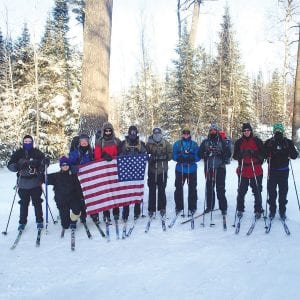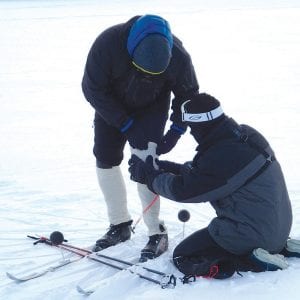This team from the Combat Wounded Veteran Challenge braved arctic temperatures in January to find out how prosthetic limbs function in extreme cold. Despite the brutal temperatures, team members enjoyed their time in the peaceful Northwoods. Left: A student from St. Petersburg College checks the markers that record the movement of a veteran’s prosthetic lower limb.

When most of Cook County was hunkered down at home to stay out of the bitter cold, a group of 10 combat wounded and injured veterans—many from warmer climes— spent a week skiing and exploring the Poplar Creek and Banadad Ski Trails in the Boundary Waters Canoe Area Wilderness, hosted by Ted and Barb Young of Boundary Country Trekking.
For most Nordic skiers, these conditions—minus 28 degrees without the windchill factor—are far too extreme. But for these wounded warriors, the severe arctic conditions were perfect for conducting medical research on lower limb amputees who sacrificed their limbs while fighting our nation’s wars, explained Captain David R. Olson (Retired), executive director of Combat Wounded Veteran Challenge.
Reached by phone after the Gunflint Trail adventure, Captain Olson said a team of 10 wounded warriors and their support team arrived quietly in Grand Marais on January 2, 2014 for a week-long research project.
The team was comprised of veterans from the Combat Wounded Veteran Challenge and the J.E. Hanger College of Orthotics and Prosthetics at St. Petersburg College, Florida. It was an interesting mix of people and personalities, said Olson. Some participants are still active duty military who get special liberty to do these tests. Some are medically retired.
“We have folks from Seattle, Tennessee, California. One is training to be a Navy Seal from San Diego, California. That’s Joe, who is pretty laid back, more comfortable on a surfboard than on cross country skis,” he said.
On January 5, the team departed Bearskin Lodge and set out on the Poplar Creek Ski Trail. Their journey ended January 7 when they arrived at Gunflint Lodge.
Two students in the St. Petersburg orthotic and prosthetic program monitored the progress of the lower limb amputees. They had the amputees use five different prosthetic feet to see what design features work best. The study consisted of suiting up the participating wounded warrior amputees and “control” skiers with lower extremity joint markers (identifiers) while hours of video were taken of them skiing in the subzero temperatures. The students will use the video data to compare the performance of the various prosthetics.
Olson said, “The ultimate goal is to further improve future prosthetic foot designs that will better enable amputees who wish to partake in this form of skiing.”
Asked if there were any surprises during the study, Olson said yes. He said one “aha” moment was when one of the amputees couldn’t feel his residual limb. The circulation is not the same in the residual limb. The amputee became concerned about the loss of feeling and took off his ski and walked. His decision saved him from frostbite or other injury.
Olson explained, “The socket is fiberglass. It conducted the cold into the residual limb, so his leg was freezing. He didn’t know it until it got to his hip. When he walked, that friction on the prosthetic generated circulation. Another 20 minutes and he would have had frostbite.”
The St. Petersburg orthotic and prosthetic program is now working on a new socket. “It will sense the temperature in the residual limb and warm up—or cool down,” said Olson, noting that amputees also experience problems in extreme heat.
The same group that endured some of Minnesota’s coldest temperatures also experienced some of Arizona’s worst. This group also traveled to the inner Grand Canyon in 115 degree heat. There, the amputee’s residual limb got overheated and swollen, leading to bleeding and extreme discomfort.
Incidents like that, said Olson are part of the reason he so enjoys working with the Combat Wounded Veteran Challenge. “We didn’t set out to analyze residual limbs,” he said, “We were looking at foot and ankle movement. But we learned something very important to our combat wounded veterans.”
Olson said the challenge also helps veterans with the wounds that are not visible. “When people are forcibly retired, they ask, ‘What am I going to do with my life?’ When they hear about things like this, they wonder if they can do things like this and it provides an inspirational push. They can see—if these guys can do this—I can try it. I can do something with my life,” said Olson.
Olson noted that there were two people with traumatic brain injury (TBI) on the Gunflint Trail expedition. “They are the ones you don’t notice on the outside. But there are some major, major injuries,” said Olson. “Being outside like this, being with others who have TBI, they say, ‘When I get out with you, I feel great. I need less medication.’”
Shortly after talking to the Cook County News- Herald, Olson was heading to a meeting with the George W. Bush Institute’s Military Service Initiative and the Center for Brain Health to consider ways the Combat Wounded Veteran Challenge could work with them on TBI and post-traumatic stress disorder issues.
“We can’t pretend to be everything, so we are reaching out to bring another treatment. With every case, we walk away with case studies. Every time we find out something,” said Olson.
And one thing Olson found out in the latest adventure was how welcome his team was to the Gunflint Trail. They spent a few nights at Bearskin Lodge and several evenings with the Youngs at Poplar Creek Guesthouse. “The quality time we spent in the evenings with Ted and Barb, there is nothing more pleasurable than that,” he said.
The Combat Wounded Veteran Challenge would like to make this an annual event, incorporating winter camping, mushing, and snowshoes. But before planning for another visit, Olson was off with a team to Argentina for a monthlong mountain climb of 20,000 feet. “It is summer there, but cold. It will be another team building exercise, building some esprit de corps.”
All part of the Combat Wounded Warrior Challenge mission: To challenge, research, inspire.
The Combat Wounded Veteran Challenge is a veteran assistance program that conducts rehabilitative high-adventure challenges that further the medical sciences associated with their injuries. The organization was founded in 2010 for wounded warriors to re-engage in the adventurous and challenging outdoor activities they once enjoyed, and to inspire others who may have lost hope.
More information can be found at www.combatwounded.org.



Loading Comments